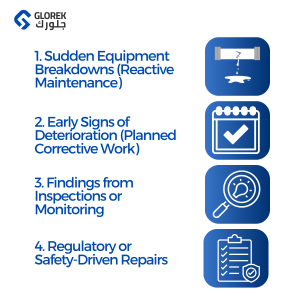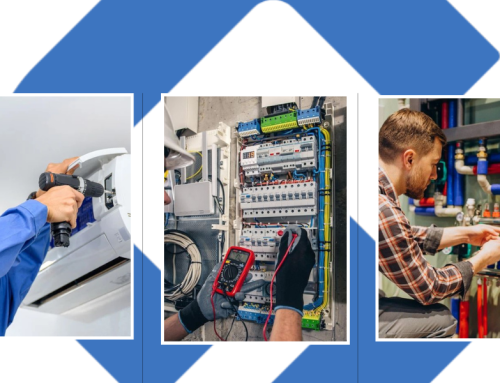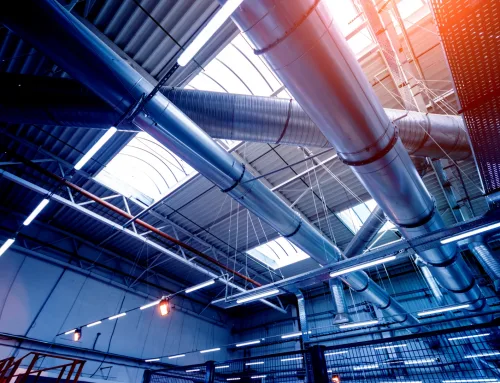In today’s industrial and facility management landscape, maintenance is no longer a secondary concern—it’s a strategic necessity. Among the various approaches, corrective maintenance continues to play a critical role.
No matter how strong your maintenance program is, failures can and do happen. That’s where corrective maintenance comes in—a strategy focused on diagnosing and fixing equipment after unexpected issues arise. While it’s reactive by nature, corrective maintenance is a critical part of any industrial or facility management plan.
When executed efficiently, it reduces downtime, controls costs, and extends asset life. But if poorly managed, it can lead to production delays, higher expenses, and recurring failures. This article explores the role of corrective maintenance in industrial operations, its key types, and how to apply it strategically for maximum impact.
This blog explores what corrective maintenance is, its benefits, types, ideal application timing, how it compares with other strategies, and how industries can optimize their maintenance operations for long-term efficiency.
1. What is Corrective Maintenance?
Corrective maintenance is a reactive approach to maintenance that involves repairing or replacing components after a fault or failure has occurred. Unlike preventive or predictive maintenance, corrective actions are unplanned and take place in response to real-time breakdowns. For many non-critical systems or low-risk environments, corrective maintenance offers a cost-effective and straightforward solution. While it may appear as a last resort, it remains a vital part of a comprehensive asset management strategy, especially when balanced with other proactive techniques.
2. Benefits of Corrective Maintenance
Despite its reactive nature, corrective maintenance offers several practical benefits, especially for businesses operating with lean resources or where non-critical equipment is involved. Some key advantages include:
Lower Upfront Cost
Unlike preventive or predictive maintenance, corrective maintenance does not require significant investment in monitoring tools, sensors, or complex planning. You only spend when a failure occurs, making it a cost-efficient option for assets that don’t justify constant oversight.
Immediate Problem Resolution
Corrective maintenance is action-oriented. When a breakdown happens, the focus shifts directly to diagnosing and fixing the issue, allowing operations to resume quickly. This responsiveness is critical in fast-paced industries where every minute of downtime can affect productivity.
Operational Simplicity
The process is straightforward—no scheduling algorithms, condition monitoring, or analytics are required. It depends primarily on having a skilled maintenance team ready to act when something goes wrong, which simplifies both planning and execution.
Practical for Non-Critical Assets
For equipment that doesn’t impact safety or core operations, it may be more economical to allow it to run until failure. In such cases, corrective maintenance helps avoid unnecessary preventive servicing, saving time and cost.
Asset Life Extension
Although it deals with breakdowns, corrective maintenance still contributes to asset longevity when done properly. Timely repairs prevent small issues from escalating, helping maintain asset performance over time.
Corrective Maintenance offers a smart, resource-efficient solution for managing equipment that doesn’t need constant monitoring. By integrating it thoughtfully into your overall strategy, you can balance cost, efficiency, and uptime without overcomplicating operations.
3. Types of Corrective Maintenance
Corrective maintenance can be divided into four primary types, depending on urgency, planning, and condition:
Immediate (Emergency):
This type is executed immediately after a failure occurs, often to prevent production loss or safety risks. Emergency repair teams are mobilized quickly.
Deferred (Planned):
Non-urgent corrective actions are scheduled for a more convenient time, often during non-peak hours or planned downtime.
Conditional Corrective:
These are triggered by signs of wear or declining performance discovered during inspections or routine monitoring but haven’t caused failure yet.
Run-to-Failure:
In this approach, equipment is allowed to run until it breaks, at which point corrective maintenance is performed. It’s usually applied to low-cost or easily replaceable assets.
Identifying the right type of corrective maintenance for each asset is crucial to optimize both cost and performance.
4. When is Corrective Maintenance Performed?
Corrective maintenance is generally performed after a breakdown has been detected, but there are nuances in timing based on asset criticality and business needs. It is most commonly executed when:
-
A system stops functioning entirely.
-
Visual, auditory, or performance indicators show signs of failure.
-
An inspection reveals damage that must be addressed.
-
Preventive schedules were missed or ineffective.
-
Budget constraints make proactive maintenance unfeasible.
It’s particularly common in older systems, where the cost of upgrades or monitoring tools does not justify preventive strategies.
Common Scenarios Where Corrective Maintenance Is Essential
Even with regular upkeep, equipment can still develop issues that require immediate attention. Corrective maintenance becomes necessary in various real-world situations, especially when reliability, safety, or compliance are at stake. Below are four typical scenarios where corrective action is required to keep operations on track.
1. Sudden Equipment Breakdowns (Reactive Maintenance)
When machinery fails unexpectedly, teams must act fast to restore functionality. These failures often occur when equipment is operated until it breaks—an approach known as run-to-failure.
2. Early Signs of Deterioration (Planned Corrective Work)
Sometimes, equipment shows signs of wear before a full failure occurs. If caught early, teams can plan the repair during non-peak hours to avoid disruption.
3. Findings from Inspections or Monitoring
Issues discovered during preventive checks or condition monitoring often lead to necessary corrective tasks to prevent future breakdowns.
4. Regulatory or Safety-Driven Repairs
External inspections—especially those tied to industry regulations—may mandate immediate corrective action to remain in compliance.
Corrective maintenance isn’t just about fixing what’s broken—it’s about responding quickly, minimizing impact, and maintaining compliance. Recognizing these scenarios helps teams stay prepared and maintain operational stability across industries.

5. Corrective Maintenance Best Practices
To ensure that corrective maintenance doesn’t become chaotic or overly disruptive, organizations should follow structured best practices:
-
Implement a CMMS (Computerized Maintenance Management System) to track fault reports, equipment history, and response times.
-
Conduct Root Cause Analysis (RCA) after each failure to understand why the issue happened and prevent its recurrence.
-
Classify Equipment by Criticality to help prioritize maintenance tasks and allocate resources effectively.
-
Prepare an Emergency Response Protocol to enable fast action in case of urgent failures.
-
Train Maintenance Teams not just in repair, but in identifying early signs of failure and documenting actions taken.
Following these practices helps convert a purely reactive approach into a more controlled and data-informed process.
6. Corrective vs. Preventive vs. Predictive Maintenance
Understanding how corrective maintenance fits within the broader maintenance landscape is key to choosing the right strategy. Here’s how they differ:
-
Corrective Maintenance is reactive—performed only after failure.
-
Preventive Maintenance is scheduled at regular intervals to prevent breakdowns, based on time or usage.
-
Predictive Maintenance uses real-time data and sensor analytics to forecast failures before they happen.
Each strategy has its place. Corrective maintenance works best for non-critical, low-risk assets; preventive suits equipment with predictable wear patterns; predictive is ideal for high-value systems where downtime is costly.
7. How to Improve Maintenance in Your Industry
For industries aiming to enhance reliability and reduce total maintenance costs, the key is not to rely solely on corrective actions, but to implement a balanced strategy:
-
Adopt a Hybrid Maintenance Model that blends corrective, preventive, and predictive methods based on asset criticality and ROI.
-
Use Data Analytics and KPIs to track downtime, failure frequency, and Mean Time to Repair (MTTR) for better planning.
-
Invest in CMMS Tools to centralize asset data, manage work orders, and automate scheduling.
-
Upskill Your Workforce with training in diagnostics, automation, and root-cause analysis.
-
Standardize Reporting to create consistency across teams and improve long-term strategy development.
The shift from reactive to proactive maintenance is not just a cost decision—it’s a strategic transformation that leads to longer asset life, improved safety, and greater operational resilience.



